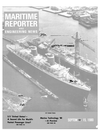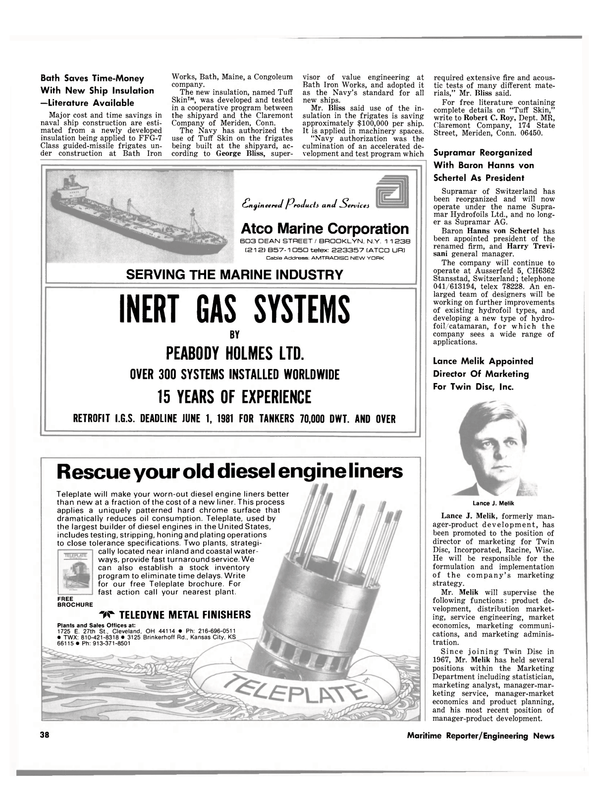
New UPSCO Shipyard Begins Production
An entirely new shipyard, programmed to build commercial tug/ barge units, is now in operation in Ontonagon, Mich.
Upper Peninsula Shipbuilding Company (UPSCO), a privately owned firm, was formed in May of 1979 when its president, Charles H. Kerkman, together with Robert J. Rotundo and Robert D.
Fischl, saw a need for efficient vessel systems that would offer low-cost water transportation on the Great Lakes. Comprehensive transportation studies involving rail and truck traffic in the Great Lakes area clearly indicated savings to the many shippers who could use cross-lake water transportation as an alternative to a r o u n d - t h e - l a k e rail or truck forms of shipping.
These studies showed that the integrated t u g / b a r g e concept seemed to offer the most efficient s y s t em in h a n d l i n g cross-lake needs on a shuttle basis. Frequent service on a closely scheduled timetable would smooth the peaks and valleys, and reduce the "dead time" during loading and unloading of cargoes. UPSCO feels that the integrated tug/barge concept is ideally adapted to the needs of cross-lake railroad car shuttle service between Michigan and Wisconsin railhead ports.
The first vessels being built at the new UPSCO yard are part of an integrated tug/barge system for the State of Michigan. The initial contract with the state specifies a system comprising one tug and four barges (forebodies).
Production of the system is now under way, with deliveries planned over the next three years.
The tug in the UPSCO system is 120 feet long, powered by two MaK 4,000-bhp turbocharged diesel engines driving controllablepitch propellers. The engines are designed to operate on residual fuels, providing low-cost operation.
Each barge will be 437 feet long with a beam of 64 feet; LOA of the tug/barge unit will be 484 feet.
The barges will be fully enclosed utilizing Navaire bow doors, and will accommodate 28 railroad cars. The mechanism to connect the tug and barge will be manufactured under license from ACB of France.
UPSCO engaged Breit & Garcia, a New Orleans naval architecture firm with a great deal of experience and an international reputation in the development of integrated tug/barges, to design the complete system.
Construction of the Upper Peninsula Shipbuilding yard began in November 1979. In less than seven months, on June 2, 1980, vessel fabrication was started.
The main fabrication building has an area of 60,000 square feet, with an adjoining five-floor production office building. Module building is carried out under four P&H bridge cranes, each having a span of 125 feet and 70 feet under the hook; two have a capacity of 50 tons and two are 1 5 - t o n cranes. Administration, trades, warehouse, and other support buildings are now under construction, scheduled for completion by the end of this year.
Installation of the latest in steel-treatment, transport, fabrication, and lifting equipment ensures the cost efficiency of UPSCO's operation. Major items of equipment include a Pangborn metal-processing system, the latest computer-automated Linde metal-cutting equipment, a highcapacity Ogden welding line, and a 750-ton Pacific press. Outside lifting will be handled by a Manitowoc model 4100W crawler crane.
One of the major undertakings is the staffing of the company.
UPSCO is building its organization on a scheduled basis, both in the areas of management and hourly employees. Knowledgeable, experienced personnel have been brought into the company in all areas.
In cooperation with the Michigan Department of Labor, employee training schools have been under way for several months.
Total employment during July this year reached 85 people; fullproduction employment level will range between 400 and 450 workers.
Read New UPSCO Shipyard Begins Production in Pdf, Flash or Html5 edition of September 15, 1980 Maritime Reporter
Other stories from September 15, 1980 issue
Content
- MMS Forms Subsidiary To Serve Clients In United Kingdom/Europe page: 4
- J.M. Colonell Appointed Senior Project Engineer For Woodward-Clyde page: 4
- Third Navy Destroyer Tender Launched At NASSCO Yard page: 6
- SSI Introduces Emergency Anchor Windlass System- Literature Available page: 6
- F. Shepherd Promoted At Designers & Planners— Pramud Rawat Joins Firm page: 7
- Canonie Forms New Subsidiary- Appoints Three New Executives page: 10
- Armco Restructures Western Steel Division Into Three Groups page: 10
- Toronto Firm Proposes Truck/Trailer RO/RO Run Across Lake Ontario page: 11
- Avondale Lays Keel For Fourth Navy Fleet Oiler page: 12
- TBW Industries Gets $5-Million Order For SMATCO Deck Equipment page: 12
- Thomas Ternes Joins Guralnick Associates As Supervisory Engineer page: 13
- HUD Moves Head Office To Tsing Yi Island— Kowloon Yard Closed page: 13
- Multi-Purpose Mobilization Ship page: 14
- S/S 'United States'— A Second Life For World's Fastest Passenger Liner? page: 14
- Dixie Dredge Delivers Four Vessels To Egyptian Dredging page: 18
- Twin Disc Forms New Task Force To Market Marine Transmissions page: 18
- Quality Delivers Towing/Supply Vessel To Gulf Fleet Marine page: 18
- New Company Will Offer Underwater Vehicle Inspection Services page: 22
- Ferrous Has Proportioning Pump For Fuel Additive- Literature Available page: 22
- Joseph Quinn Named President Of Reorganized Devoe Marine Coatings page: 23
- Furuno Radar Simulator Installed At California Maritime Academy page: 23
- Boeing Jetfoil Sold To Argentine Owner—Christened Montevideo Jet page: 24
- National Supply Patents Subsea Template System —Literature Available page: 25
- Hitachi Gets Jackup Rig Orders From Danish And Netherlands Owners page: 26
- E.H. Barron Joins Overseas Enterprises As Director Of Chartering page: 26
- New Brochure On Gears And Gear Units Now Available From Farrel page: 26
- Promet Gets Repeat Orders From Two U.S. Companies page: 28
- New Jackup Drilling Rig page: 30
- AWO's Shipyard Conference Honors Renshaw For Leadership page: 30
- Wichita Has PTOs For Large Diesel Engines- Literature Available page: 32
- New UPSCO Shipyard Begins Production page: 36
- Bath Saves Time-Money With New Ship Insulation —Literature Available page: 38
- Lance Melik Appointed Director Of Marketing For Twin Disc, Inc. page: 38
- MTC '80 page: 40
- Rockwell Publishes New Cast Steel Valve Catalog page: 42
- MarAd Awards CDS For Mormac Conversions To Cost $4.4 Million Total page: 42
- New Brochure Explaining Combustion Catalysts Available From Ferrous page: 42
- MarAd Study Reports $9.8 Billion Needed To Expand U.S. Ports page: 43
- Coal-Burning Bulkers Ordered From Yards In Italy And Japan page: 48
- CDI Marine Awarded Navy Design Contracts Totaling $3.2 Million page: 48
- Tacoma Boat To Build Nine USCG Cutters At Cost Of $646 Million page: 50
- Michigan Wheel Will Market Bow Thrusters —Literature Available page: 51
- U.S. Yards Invited To Bid On First Maritime Prepositioning Ships page: 51
- Dravo Lays Keel For Towboat Ordered By People's Republic Of China page: 52
- Jeffboat-Built 'Conti-Karla7 Christened At Chicago's Navy Pier page: 53
- Mid-Coast Marine Delivers Second Trawler And Tugboat page: 54


